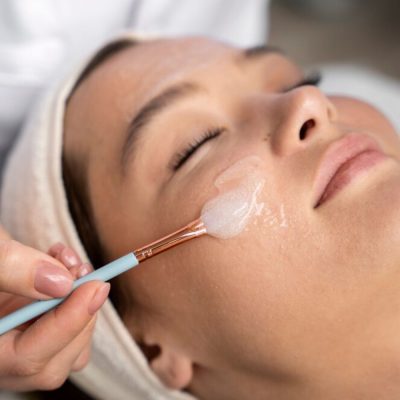Chemical Peels
Chemical peels are a popular and effective cosmetic treatment used to improve the appearance of the skin by exfoliating the outer layers and promoting regeneration. It involves the application of a chemical solution to the skin, causing controlled exfoliation and peeling, revealing fresher, smoother and more youthful-looking skin beneath. Chemical peels can help to address a variety of skin concerns, including acne, hyperpigmentation, fine lines, and uneven texture.

What are Chemical Peels?
Chemical peels are designed to rejuvenate the skin by removing damaged outer layers. The treatment can be customized based on the depth and intensity required to target specific skin issues, such as acne scars, sun damage, and signs of aging. Chemical peels help in achieving smoother and more radiant skin by stimulating collagen production and promoting cell turnover.
Types of Chemical Peels
Chemical peels vary based on strength and the depth to be targeted. They are classified into three main categories:
- Overview: Mild acids like alpha-hydroxy acids (AHAs) or beta-hydroxy acids (BHAs) are used to gently exfoliate the outermost layer of the skin.
- Target Concerns: Ideal for treating mild acne, fine lines, and minor pigmentation issues.
- Downtime: Minimal downtime, with mild redness and peeling that typically resolves within a few days.
- Example: Combi Peel
- Overview: Medium peels use stronger acids, such as trichloroacetic acid (TCA), to penetrate deeper into the skin layers, providing more dramatic results.
- Target Concerns: Effective in treating moderate wrinkles, acne scars, and hyperpigmentation.
- Downtime: Requires a recovery period of about a week, with noticeable peeling and redness.
- Example: Yellow peel, Cosmelan
- Overview: Deep peels use potent chemicals like phenol or high concentrations of trichloroacetic acid (TCA) to deeply exfoliate the skin.
- Target Concerns: Best suited for severe wrinkles, deep scars and significant sun damage.
- Downtime: Longer recovery time, typically two weeks or more, with extensive peeling, swelling and redness.
- Example: Phenol peel, High concentration trichloroacetic acid (TCA) peel.
Method & Treatment of Chemical Peels
Treatment Procedure
Consultation
A qualified dermatologist thoroughly assesses the patient’s skin type, concerns, and suitability for chemical peel treatment.
Preparation
The skin is properly cleaned, and protective measures are taken to shield sensitive areas, such as the eyes and hairline.
Application
A chemical solution is carefully applied to the skin using a brush. It is left on the skin for a specified time to achieve the desired level of exfoliation. The duration is determined by a dermatologist to provide the best outcome.
Neutralization
After the time has passed, the peel is neutralized (if required) and removed, and post-treatment care products are applied to soothe the skin.
Post-Treatment Care
Patients are advised on post-treatment care, including sun protection and the use of gentle skincare products to support healing. These guidelines must be properly adhered to, to ensure the best outcomes.
Applied Areas for Chemical Peels
Chemical peels can be applied to various parts of the body to address specific skin concerns:
Face
To reduce fine lines, improve texture, and address pigmentation.
Neck
To rejuvenate skin tone and reduce signs of aging.
Hands
To lighten age spots and improve skin texture.
Back
For treating acne and scarring.
Precautions and Risks of Chemical Peels
- Strict sun protection is crucial before and after the treatment to prevent pigmentation changes.
- Some patients may require some pre-peel preparations like using retinoids or bleaching agents for optimal results.
- Individuals with active infections or certain skin conditions, such as eczema, should avoid chemical peels.
- Mild to moderate redness and swelling are common side effects. The severity may depend on the peel’s depth.
- Some peeling and flaking are expected and varies based on the type of peel used. Proper hydration and moisturization is important to minimize this.
- Some patients, particularly individuals with darker skin tones may experience some changes in skin color.
- Infections are rare, however, properly following post-procedure care instructions minimizes the chances.
Post-Procedure Signs to Look Out For
Mild Redness & Sensitivity: This is a common side effect immediately following the peel and may last for a few hours to days.
Tingling or Burning Sensation: A temporary tingling or burning sensation may occur which typically subsides within hours.
Peeling or Flaking: As the skin exfoliates, peeling or flaking is expected and indicates the peel is working.
Improvement in Skin Texture: Visible improvements in skin texture and tone can be expected within a few weeks as the new skin regenerates.
Complementary Cosmetic Procedures for Better Outcomes
Chemical peels can be combined with other cosmetic treatments for enhanced results, offering a comprehensive approach to skin rejuvenation:
Microneedling Radio Frequency (MNRF):
Combining chemical peels with MNRF can improve collagen production and enhance the penetration of active ingredients.
Laser Resurfacing
Laser treatments can target deeper layers of the skin, complementing the surface exfoliation provided by chemical peels.
